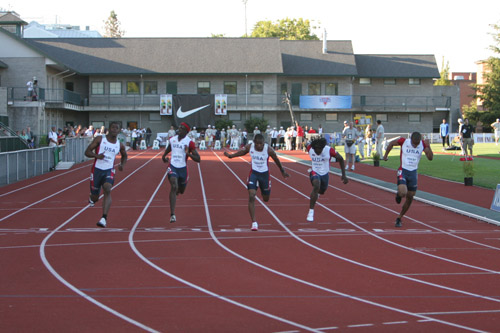2006
Results
Pictures
Race
Website
Heat Sheets
Meet Preview
Meet Schedule
Video
|
Team USA's 43.29 4x100 Women's World Jr. Record and
Walter Henning's American Junior Record Hammer Throws Lead the Way
- Team of Bianca Knight MS, Jeneba Tarmoh CA, Elizabeth Olear CA, and Gabby Mayo NC combine to lower 1999 4x1 WJR of 43.38 - Knight, unfortunately, pulled her hamstring and will miss Beijing
- Walter Henning NY hits 237-02 on first throw, 238-02 on final throw, both exceeding his own 235-00 mark from USATF Jrs. this year
- Quick Junior-Only 300s - Sa'de Williams CA 37.13 (over Brandi Cross TX and Jessica Beard OH) and Bryshon Nellum CA 33.19 (over Calvin Smith FL and Karjuan Williams NC) in rarely-run event.
- After losing to her at USATF JOs, Mayo nips Kenyanna Wilson AZ in 100, 11.42-11.43.
- The pros: LaShawn Merritt's 31.31 300 is #2 all-time and Matt Tegankamp PRs with 3:36.07 1500
World Record Women - by Dave Devine
You could tell it would be a good night for US Junior athletes
when the press box officials were scrambling to pull up a webpage
labeled IAAF Application for World Junior Record before
the National Anthem had even been sung.
The two 4x100 meter races—assembled to prepare the Junior
squads for stick-carrying duties in Beijing—were so low-key
that they were relegated to a pre-meet timeslot and never announced
to the media. Arriving fans were still settling into their
seats and enjoying the late afternoon sun when first the Junior
men, and then the Junior women, ran Red vs. Blue races with the
available relay pools.
Willie Perry drew some attention anchoring the Men’s USA
Red team (Dennis Martin, Gordon McKenzie, Chris Dykes, Willie
Perry ) to an impressive 39.43 win over a Blue team consisting
of Evander Wells, Odell Harris, Arthur Wims and Brandon Myers
(40.29), but nothing prepared the crowd for what came next.
 Bianca
Knight led
off a Women’s Blue
team that included Jeneba Tarmoh on the second
leg, Elizabeth Olear on third, and emerging
superstar Gabby Mayo (right) on anchor. Knight
injured her hamstring on the leadoff, but still managed a clean
exchange to Tarmoh, who ripped down the backstretch past a grandstand
still unaware of what it was witnessing. By the time Olear
got a crisp exchange to Mayo at the top of the homestretch, Mayo
was clear of Red team anchor Alexandria Anderson and ready to
power home. Power she did, to a new World Junior
Record of 43.29, taking down the seven year-old mark
of 43.38 set by the USA in 1999. Bianca
Knight led
off a Women’s Blue
team that included Jeneba Tarmoh on the second
leg, Elizabeth Olear on third, and emerging
superstar Gabby Mayo (right) on anchor. Knight
injured her hamstring on the leadoff, but still managed a clean
exchange to Tarmoh, who ripped down the backstretch past a grandstand
still unaware of what it was witnessing. By the time Olear
got a crisp exchange to Mayo at the top of the homestretch, Mayo
was clear of Red team anchor Alexandria Anderson and ready to
power home. Power she did, to a new World Junior
Record of 43.29, taking down the seven year-old mark
of 43.38 set by the USA in 1999.
Knight, scheduled to return for
a face-off with Olympians in the Women’s 200m, was finished for the night. (In
fact, it appears she is finished for the season. The hamstring
pull will prevent her from traveling to Beijing and sideline
her for up to six weeks.) Her relay mate Mayo, however,
was just getting started. Mayo returned roughly an hour
later to take down a loaded Junior-only 100m field that included
Tarmoh, Olear, and US Junior National champion Alexandria Anderson. She
crossed the line in a wind-legal 11.42, with a fast-starting
Kenyanna Wilson slipping to 2nd (11.43) and Anderson relegated
to 3rd in 11.46.
Impressed with the sizable Tuesday-night crowd
and supportive atmosphere at Hayward field, Mayo is looking forward
to a return trip. "It was great. I can't wait to come back in
'08," she said with a knowing smile.
-----------------------------------------------------------------------------------------------------------------------------------------------------------
Henning Hammers Another Record - by Dave Devine
When St. Anthony’s, NY senior-to-be Walter Henning (below
left) stepped into the Hayward Field hammer ring for his final
throw of the evening—distinctive red-and-white-striped
socks hiked to his knees—he was working at a slight disadvantage. His
own hammer had been mangled in a cage collision on his errant
second toss, which left him swinging borrowed equipment for his
last attempt. It didn’t matter. Henning settled
into the ring, began a tight rotation, let out a primordial yell
and unfurled the hammer into the descending twilight.
“I didn’t think it was going to be a record throw,” he
said later, “but I thought it would be close.”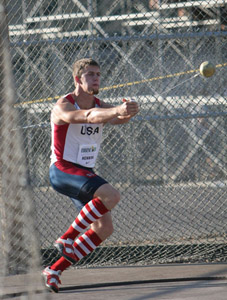
Henning had already laid waste to the US Junior record he’d
set only weeks ago at the Junior National meet. His first
throw in Eugene traveled 237-1, a two foot improvement
on his previous record of 235-0. By the time this one fell
out of the sky it had traveled 238 feet 2 inches, dislodging
a massive divot from the sector and tacking another foot onto
the Junior record.
Afterwards, an excited Henning commented on
the enthusiastic support at Hayward Field. “To have a crowd
like this, especially to have a crowd out at the hammer area,
that’s special.” He also mentioned the lift he received
from competing with post-collegiate throwers. “I threw
with some of these guys up at the Penn Relays, but it’s
my first time throwing with AG [Kruger] and Kibwe Johnson. It’s
a real honor to be throwing with these guys.”
Kruger, the 2006 US National champion and 2004 Olympian, returned
the admiration. “This is great. I didn’t start
throwing until I was 21, so it’s nice to see [Walter] get
development and start to throw far when he’s young.”
Another elite in the field was former prep stud Jacob Freeman,
the 2004 NCAA champion and 2006 US Nationals runner-up. Freeman
still holds the national high school record of 253-3 with the
12 pound implement, but Henning’s best is only nine inches
shy. According to Henning, Freeman corralled his young
pursuer before the competition and passed along a friendly request. “He
asked me not to throw the 12 pound hammer next year,” Henning
said, laughing, “so I guess I got him a little scared.”
Pressed on whether Freeman’s record is an actual goal
for his senior year, Henning turned a bit more serious. “You
can’t go for distance,” he said. “You go for
winning big meets. That’s what you go for.”
-----------------------------------------------------------------------------------------------------------------------------------------------------------
Lessons in the Long Shadows - by Dave Devine
AJ Acosta (right) knew he was in over his head. He’d
heard discussions leading up to Tuesday’s 1500m that the
pace would go out in 1:54 for the first 800. The previous
night, he’d let it be known that if the leaders hit that
mark, he’d be nowhere near the front.
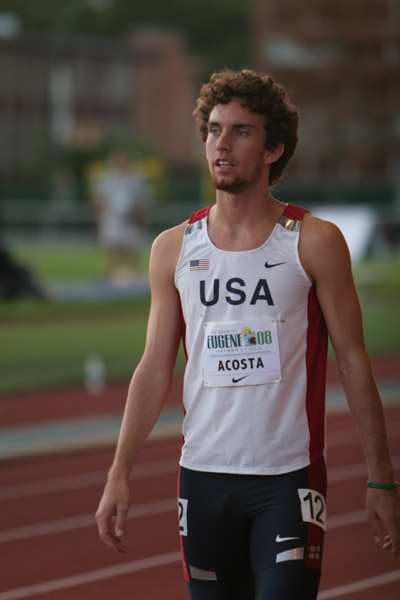 When the gun went off, former US champion Jason Lunn shot to
the lead, stringing out the field and dragging it through splits
of 56.3 and 1:54.5. Acosta’s fellow Junior team member
Andrew Bumbalough—apparently either pacing or running a
workout—tucked in gamely behind, followed by Matt Tegenkamp,
Said Ahmed and Anthony Famiglietti. The pack split in two,
with Acosta near the back of the second grouping. “I
was hanging off the back end on purpose,” he said, “I
knew it was going to go out fast.” When the gun went off, former US champion Jason Lunn shot to
the lead, stringing out the field and dragging it through splits
of 56.3 and 1:54.5. Acosta’s fellow Junior team member
Andrew Bumbalough—apparently either pacing or running a
workout—tucked in gamely behind, followed by Matt Tegenkamp,
Said Ahmed and Anthony Famiglietti. The pack split in two,
with Acosta near the back of the second grouping. “I
was hanging off the back end on purpose,” he said, “I
knew it was going to go out fast.”
Bumbalough dropped out with 500 to go, and Lunn stepped off
the track at the bell. As the pace ratcheted up and the
second pack splintered, Acosta was left in a gap with no one
to pursue. “My splits were pretty much spot-on,” he
said. “I was just out in no man’s land. With
people there, I think I could have gone a bit faster.”
Up front, Matt Tegenkamp was demonstrating why he’s one
of the hottest American distance runners of the summer. With
his 13:04 5k fitness on full display, he waged a grinding battle
with the current US 1500 list-leader, Said Ahmed, before dropping
a gear no one else in the field possessed. Acosta could
only watch from the long shadows of the grandstand on the far
turn.
After the race, he was more buoyant than disappointed. “I
just didn’t have anyone to reel in at the end,” he
said. “I’m a little bummed, but these guys are awesome.” Nodding
at the elites pulling on sweats after the race, he added, “This
is where I want to be in five years.”
One post-collegian in particular drew Acosta’s respect. “I’m
a huge Gabe Jennings fan. To see him come back and running
this well is exciting because he’s a big personality who
brings a lot to track and field. I really respect that. He’s
such an eccentric. In a lot of ways I see myself in him.”
The similarities are not unfounded. Both runners emerged
from high school with mile PRs hovering near 4:03. Both
joined college programs in the midst of rebuilding projects,
authored by the highly-respected Vin Lananna. And both
possess a certain charisma paired with a precocious talent.
“I don’t want to be the next Gabe Jennings though,” Acosta
was quick to add, “I want to make my own name.” When
asked if that meant he’d be leaving the conga drums at home
when he packs for college, he laughed and shook his head. “I’m
not going to bring any conga drums with me, but hopefully we can
get the Nation out.”
-----------------------------------------------------------------------------------------------------------------------------------------------------------
Dealing with an Unfamiliar Distance - by Dave
Devine
Running 300 meters on an outdoor track in the middle of the
summer was a curveball for almost everybody in the field. Karjuan
Williams, normally a half miler, but known to drop a
fast relay split from time to time, was certainly out of his
element. “I don’t run sprints a lot,” he
said, “and I’ve never run a 300 before.”
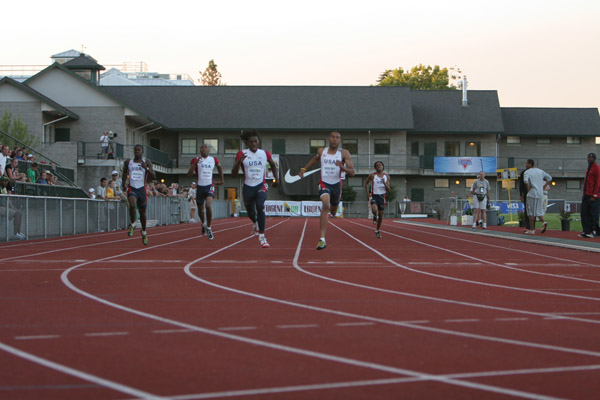 400
meter specialist Bryshon Nellum was
in a similar boat. “This was my first time running
the 300 outdoors,” he said. “It’s different
coming off the straight. I’m used to coming out the
curve in the 400 or the 200. 400
meter specialist Bryshon Nellum was
in a similar boat. “This was my first time running
the 300 outdoors,” he said. “It’s different
coming off the straight. I’m used to coming out the
curve in the 400 or the 200.
Without a 400 or an 800 on the meet
schedule, both men folded into the blocks near the top of the
backstretch for the Juniors-only section of the 300 meters. Colorado
star JT Scheurman was
out fastest, charging up the straight in lane 3 and making up
the stagger on the field. His lead was short-lived, however,
as his form disintegrated and he clutched at his hamstring heading
into the curve.
“I didn’t see him,” Nellum said, “I
was just trying to make sure I got out.” Running
one lane over from the hobbled Scheurman, in lane 4, Nellum was
trying to break the unfamiliar race into parts. “I
ran the straight as a 100, and then, when I hit the curve, I
looked at it as a 200.”
Out in lane 7, Williams was just trying to close the gap. “I
popped up out of the blocks at the start, and I was all by myself. You
don’t come out of blocks in the 800 too much.”
With
120 meters to go, US #1 quarter miler Calvin Smith held
a narrow lead over Nellum in the middle of the track. He maintained
the advantage until 50 meters to go, when Nellum slipped by to
win in 33.19. Smith was 2nd in 33.27, and Williams got up for
an unlikely third, charging home on the outside in 34.08.
After
the race, asked about returning from the hamstring injury that
severely delayed the start of his outdoor season, Williams offered
some advice that may be helpful to his now-injured teammate,
JT Scheurman. The key, he said,
was believing he could come back. “More people need to do
that, believe in yourself. You can accomplish more than you think.”
More stories to come throughout the day!
Team USA Mens
Sprint Squad |
USA Womens
Sprint Sensations |
|
|
*Photos by Open Photo
-----------------------------------------------------------------------------------------------------------------------------------------------------------
"We want to pack Hayward Field with fans to give the U.S.
Junior Team a proper sendoff to Beijing and support the exciting
elite athletes who always compete so well in Eugene," says
Vin Lananna, co-chairman of the Eugene Local Organizing Committee
and University of Oregon associate athletic director/director
of track and field. “This meet represents the local organizing
committee's commitment to its partnership with USA Track and
Field and the Athletes Advisory Committee to provide high-performance
meets in the U.S. during the summertime.”
The meet will benefit the Professional Athletics Association
(PAA), which was established to ensure that the rights of its
professional athletes are protected and that everything possible
is being done to help athletes maximize their opportunities and
achieve their goals on and off the track. This inaugural Mid-Summer
Classic will feature many of America's top track and field athletes
who will be competing for $200,000 in prize money.
Elite athletes already committed to compete in the meet include
Allen Johnson, Olympic 110-meter hurdles gold medalist; two-time
Olympic silver medalist, in the 110-meter hurdles, Terrance Trammell,
will run the 100-meter dash; 2005 World Outdoor 400-meter hurdle
champion Bershawn Jackson; 2006 world shot put leader Christian
Cantwell and 2005 World Outdoor shot put champion and two-time
Olympic silver medalist Adam Nelson; and 2005 discus national
champion Ian Waltz.
In addition to the elite athletes, the U.S. Junior National
Team will be competing in the meet, marking the end of their
training camp in Eugene before leaving for the 2006 IAAF World
Junior Championships August 15 through 20 in Beijing, China.
The Junior team features the nation’s best up and coming
athletes, including the University of Oregon's Rebekah Noble
in the 800 meters and future Duck distance runner A.J. Acosta
of Oceanside, Calif.
The two hour meet is expected to be televised nationally and
will feature 20 events. There will be many opportunities for
young fans to participate and meet athletes, get autographs,
run a half-lap race and much more.
The meet is sponsored by Nike and the Eugene Local Organizing
Committee for the 2008 U. S. Olympic Track & Field Trials,
in partnership with the Professional Athletics Association (PAA),
USA Track & Field (USATF) and its Athletes Advisory and High
Performance Committees, the University of Oregon, and the Oregon
Track Club. The Olympic Trials will be held in Eugene at Hayward
Field, June 27 through July 6, 2008.
MEET SCHEDULE
6:25 p.m. Women’s Pole
Vault
6:27 p.m. Men’s Hammer
6:30 p.m. Men’s Discus
6:33 p.m. Women’s 100 Meter Hurdles
6:37 p.m. Women’s High Jump
6:40 p.m. Women’s Long Jump
6:43 p.m. Men’s 110 Meter Hurdles
6:50 p.m. Junior Men’s 100 Meters
6:57 p.m. Junior Women’s 100 Meters
7:00 p.m. Men’s Long Jump
7:05 p.m. Men’s 300 Meters
7:10 p.m. Men’s Pole Vault
7:15 p.m. Women’s 200 Meters
7:20 p.m. Kid’s Half-Lapper
7:32 p.m. Men’s 100 Meters
7:37 p.m. Women’s Hammer
7:40 p.m. Women’s Discus
7:42 p.m. Women’s 400 Meter Hurdles
7:45 p.m. Men’s Shot Put
7:50 p.m. Men’s 400 Meter Hurdles
8:00 p.m. Junior Men’s 300 Meters
8:07 p.m. Junior Women’s 300 Meters
8:15 p.m. Women’s 800 Meters
8:22 p.m. Men’s 1500 Meters
8:30 p.m. The Road To Eugene Distance Race |

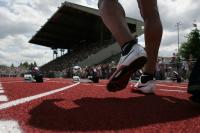
 Bianca
Knight led
off a Women’s Blue
team that included Jeneba Tarmoh on the second
leg, Elizabeth Olear on third, and emerging
superstar Gabby Mayo (right) on anchor. Knight
injured her hamstring on the leadoff, but still managed a clean
exchange to Tarmoh, who ripped down the backstretch past a grandstand
still unaware of what it was witnessing. By the time Olear
got a crisp exchange to Mayo at the top of the homestretch, Mayo
was clear of Red team anchor Alexandria Anderson and ready to
power home. Power she did, to a new World Junior
Record of 43.29, taking down the seven year-old mark
of 43.38 set by the USA in 1999.
Bianca
Knight led
off a Women’s Blue
team that included Jeneba Tarmoh on the second
leg, Elizabeth Olear on third, and emerging
superstar Gabby Mayo (right) on anchor. Knight
injured her hamstring on the leadoff, but still managed a clean
exchange to Tarmoh, who ripped down the backstretch past a grandstand
still unaware of what it was witnessing. By the time Olear
got a crisp exchange to Mayo at the top of the homestretch, Mayo
was clear of Red team anchor Alexandria Anderson and ready to
power home. Power she did, to a new World Junior
Record of 43.29, taking down the seven year-old mark
of 43.38 set by the USA in 1999.
 When the gun went off, former US champion Jason Lunn shot to
the lead, stringing out the field and dragging it through splits
of 56.3 and 1:54.5. Acosta’s fellow Junior team member
Andrew Bumbalough—apparently either pacing or running a
workout—tucked in gamely behind, followed by Matt Tegenkamp,
Said Ahmed and Anthony Famiglietti. The pack split in two,
with Acosta near the back of the second grouping. “I
was hanging off the back end on purpose,” he said, “I
knew it was going to go out fast.”
When the gun went off, former US champion Jason Lunn shot to
the lead, stringing out the field and dragging it through splits
of 56.3 and 1:54.5. Acosta’s fellow Junior team member
Andrew Bumbalough—apparently either pacing or running a
workout—tucked in gamely behind, followed by Matt Tegenkamp,
Said Ahmed and Anthony Famiglietti. The pack split in two,
with Acosta near the back of the second grouping. “I
was hanging off the back end on purpose,” he said, “I
knew it was going to go out fast.” 400
meter specialist Bryshon Nellum was
in a similar boat. “This was my first time running
the 300 outdoors,” he said. “It’s different
coming off the straight. I’m used to coming out the
curve in the 400 or the 200.
400
meter specialist Bryshon Nellum was
in a similar boat. “This was my first time running
the 300 outdoors,” he said. “It’s different
coming off the straight. I’m used to coming out the
curve in the 400 or the 200.